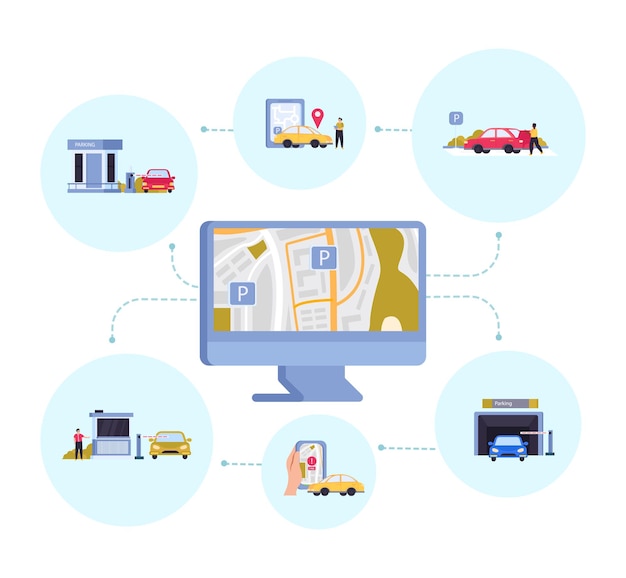Smart Traffic Management Innovations Transforming US Cities in 2025

In 2025, US cities are deploying smart traffic management systems featuring AI-powered predictive analytics, real-time adaptive traffic signals, connected vehicle technology, and advanced data analytics to optimize traffic flow, reduce congestion, and enhance urban mobility.
Imagine navigating through city streets with ease, minimal delays, and a smoother, more efficient commute. That’s the promise of the latest innovations in smart traffic management systems being deployed across US cities in 2025.
Smart traffic management systems: a 2025 overview
As urban populations continue to grow, the challenges of traffic congestion become increasingly pressing. To address these issues, US cities are investing heavily in smart traffic management systems. These systems leverage advanced technologies to optimize traffic flow, reduce congestion, and improve overall urban mobility.
The goal is to create a more connected, efficient, and sustainable transportation ecosystem that benefits both residents and businesses.

AI-powered predictive analytics
One of the most significant advancements in smart traffic management is the integration of AI-powered predictive analytics. These sophisticated systems analyze vast amounts of historical and real-time data to forecast traffic patterns and congestion hotspots, allowing for proactive adjustments to traffic signal timing and routing.
By anticipating traffic bottlenecks before they occur, cities can prevent gridlock and optimize traffic flow in real-time.
How AI is reshaping traffic forecasting
AI algorithms are capable of identifying subtle patterns and correlations in traffic data that would be impossible for humans to detect. This enables more accurate and reliable traffic forecasts, leading to better-informed decision-making by traffic engineers and transportation planners.
Benefits of predictive traffic management
Predictive traffic management not only reduces congestion but also enhances safety by anticipating potential accident locations and adjusting traffic flow accordingly. This proactive approach can significantly improve the overall transportation experience for drivers, cyclists, and pedestrians.
- Enhanced traffic flow and reduced congestion
- Improved safety through proactive accident prevention
- Optimized traffic signal timing and routing
- Better-informed decision-making by traffic engineers
The implementation of AI-powered predictive analytics is a game-changer for smart traffic management, offering a data-driven approach to optimizing urban mobility.
Real-time adaptive traffic signals
Traditional traffic signal systems operate on fixed schedules, often leading to inefficiencies and unnecessary delays. Real-time adaptive traffic signals, on the other hand, dynamically adjust their timing based on current traffic conditions, optimizing traffic flow in real-time.
These systems use sensors, cameras, and other data sources to monitor traffic volume, speed, and density, and then adjust signal timing accordingly.
The technology behind adaptive signals
Adaptive traffic signals rely on a network of sensors embedded in the roadway to collect real-time traffic data. This data is then processed by a central control system, which uses sophisticated algorithms to optimize signal timing and coordination.
- Optimized traffic flow based on real-time conditions
- Reduced congestion and travel times
- Improved air quality due to decreased idling
- Enhanced safety for drivers, cyclists, and pedestrians
The deployment of real-time adaptive traffic signals is a crucial step towards creating a more responsive and efficient urban transportation network.
Connected vehicle technology
Connected vehicle technology is another key innovation in smart traffic management. This technology enables vehicles to communicate with each other and with the surrounding infrastructure, sharing information about speed, location, and potential hazards.
This connectivity allows for more coordinated and efficient traffic flow, as well as enhanced safety and collision avoidance.
V2V and V2I communication
Connected vehicle technology encompasses two primary types of communication: vehicle-to-vehicle (V2V) and vehicle-to-infrastructure (V2I). V2V communication allows vehicles to exchange information directly with each other, while V2I communication enables vehicles to communicate with traffic signals, roadside sensors, and other infrastructure elements.

The benefits of connected vehicles
Connected vehicle technology offers a wide range of benefits, including reduced congestion, improved safety, and enhanced fuel efficiency. By sharing real-time information about traffic conditions and potential hazards, vehicles can make more informed decisions and avoid accidents.
- Reduced congestion and travel times
- Improved safety through collision avoidance
- Enhanced fuel efficiency and reduced emissions
- Real-time traffic information for drivers
The widespread adoption of connected vehicle technology has the potential to transform urban transportation, creating a safer, more efficient, and sustainable ecosystem.
Advanced data analytics
The vast amounts of data generated by smart traffic management systems require advanced data analytics to extract meaningful insights and inform decision-making. These analytical tools can identify patterns, trends, and anomalies in traffic data, providing valuable information for traffic engineers and transportation planners.
By leveraging data analytics, cities can optimize traffic flow, improve safety, and make more informed investments in transportation infrastructure.
Data mining and visualization
Advanced data analytics techniques, such as data mining and visualization, are used to identify hidden patterns and relationships in traffic data. This information can then be used to create visual representations of traffic conditions, making it easier for decision-makers to understand and respond to emerging issues.
Data-driven decision-making
By providing real-time insights into traffic patterns and trends, data analytics enables cities to make more informed decisions about traffic management and transportation planning. This data-driven approach can lead to more effective and efficient use of resources, as well as improved outcomes for residents and businesses.
- Identification of traffic patterns and trends
- Data-driven decision-making for traffic management
- Improved resource allocation for transportation infrastructure
- Enhanced transparency and accountability
The application of advanced data analytics is essential for maximizing the value of smart traffic management systems and creating a more responsive and efficient urban transportation network.
Cybersecurity and data privacy
As smart traffic management systems become more interconnected and data-driven, cybersecurity and data privacy become increasingly important considerations. These systems collect and transmit vast amounts of sensitive data, including vehicle locations, speeds, and driver behaviors.
Protecting this data from unauthorized access and misuse is essential for maintaining public trust and ensuring the integrity of the transportation network.
Addressing security vulnerabilities
Smart traffic management systems are vulnerable to a variety of cyber threats, including hacking, malware, and denial-of-service attacks. To mitigate these risks, cities must implement robust security measures, such as firewalls, intrusion detection systems, and encryption protocols.
Protecting data privacy
In addition to cybersecurity, data privacy is another critical concern. Cities must ensure that the data collected by smart traffic management systems is used only for legitimate purposes and that individuals’ privacy rights are protected. This may involve implementing data anonymization techniques, establishing clear data governance policies, and providing transparency to the public about how their data is being used.
- Robust cybersecurity measures to prevent unauthorized access
- Data anonymization techniques to protect individual privacy
- Clear data governance policies and transparency
- Compliance with relevant privacy regulations
Addressing cybersecurity and data privacy concerns is essential for building public trust and ensuring the long-term success of smart traffic management initiatives.
Challenges and future directions
While the latest innovations in smart traffic management systems offer significant potential for improving urban mobility, there are also several challenges that must be addressed. These challenges include the high cost of implementation, the need for skilled personnel, and the potential for unintended consequences.
Looking ahead, future research and development efforts will focus on addressing these challenges and further enhancing the capabilities of smart traffic management systems.
Overcoming implementation challenges
The implementation of smart traffic management systems can be expensive and complex, requiring significant investments in infrastructure, technology, and personnel. To overcome these challenges, cities must develop comprehensive implementation plans, secure adequate funding, and build strong partnerships with technology providers and other stakeholders.
Future research and development
Future research and development efforts will focus on enhancing the capabilities of smart traffic management systems, such as improving the accuracy of traffic forecasts, developing more sophisticated control algorithms, and integrating new data sources. These advancements will further optimize traffic flow, reduce congestion, and improve the overall urban transportation experience.
- Addressing implementation costs and complexities
- Developing skilled personnel and workforce
- Mitigating potential unintended consequences
- Enhancing the accuracy of traffic forecasts
By addressing these challenges and investing in future research and development, cities can continue to push the boundaries of smart traffic management and create a more sustainable and efficient urban transportation ecosystem.
| Key Innovation | Brief Description |
|---|---|
| 🤖 AI Predictive Analytics | AI forecasts traffic, adjusting signals in real-time to prevent congestion. |
| 🚥 Adaptive Traffic Signals | Signals adjust dynamically based on real-time data from sensors and cameras. |
| 🚗 Connected Vehicles | Vehicles communicate with each other and infrastructure for coordinated traffic. |
| 📊 Advanced Data Analytics | Analyzes traffic data, providing insights for optimized traffic management. |
Frequently Asked Questions
▼
A smart traffic management system uses technology like sensors, AI, and connected vehicles to optimize traffic flow and reduce congestion in urban areas.
▼
Adaptive traffic signals use real-time data to adjust timing, reducing delays and improving traffic flow compared to fixed-time signals.
▼
Connected vehicle technology enables vehicles to communicate with each other and infrastructure, sharing data about speed, location, and hazards.
▼
Data privacy ensures that personal information collected by traffic systems is protected from unauthorized access and misuse, maintaining public trust.
▼
AI enhances traffic management by predicting congestion, optimizing signal timing, and improving overall traffic flow through advanced data analysis.
Conclusion
The latest innovations in smart traffic management systems being deployed across US cities in 2025 promise a future of smoother commutes, reduced congestion, and more sustainable urban transportation. By leveraging AI, connected vehicle technology, and advanced data analytics, cities are paving the way for a more efficient and livable urban environment.





